
I've always said there are two types of people in the world:
Math people and language people.
(In case you hadn't guessed already, I'm the latter.)
Think about it: It's rare that English and Math are your favorite lessons at school.
It's one or the other, right?
Now that I've gotten older, I still stick to that philosophy—but I've learned that a combination of both math and language can help you take over the world.
Even in SEO.
Why?
Because SEO takes a village of people to make it a success.
That urgent need for strong communication—and the fact that SEO loves content—are the fundamentals of SEO.
But to create content that's bound to make an impact in the SERPs, you'll need to understand the numbers.
So, are you ready to use both math and language to build a world-dominating SEO strategy?
I'm going to unpack 19 surprising SEO stats and show you how to use them to your advantage.
Let's go!
Basic SEO Stats Everyone Should Know
First things first, let's iron out the basics.
No matter whether you're an SEO pro or just dipping your toes into the SEO waters, you'll need to know these basic search engine stats:
1. Google receives over 1.2 trillion searches every year (Internet Live Stats)
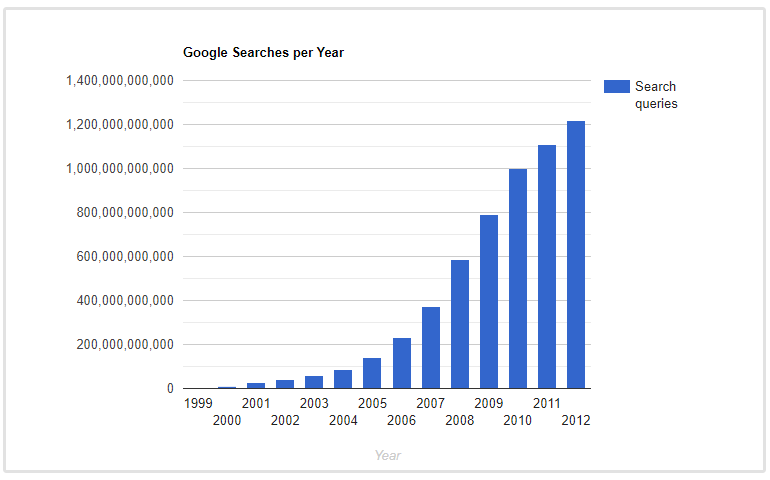
If there was ever a strong reason to believe in the value of SEO, it's this one.
Google receives billions of internet searches every single year—meaning your business's ideal customer is bound to be using a search engine to find information related to your business.
Why wouldn't you want to be in with the chance of positioning your business in front of them at such a critical point of the purchasing process?
2. Google's global revenue was $109.7 billion USD in 2017 alone (Statista)
If you're not yet convinced by Google's power, this is bound to seal the deal.
The company closed a huge amount of cash in 2017 alone through paid products and services like Google Ads, G Suite and the Google Home range.
So, the reasoning behind their huge number of yearly visitors (and gigantic market share) probably won't come as a shock.
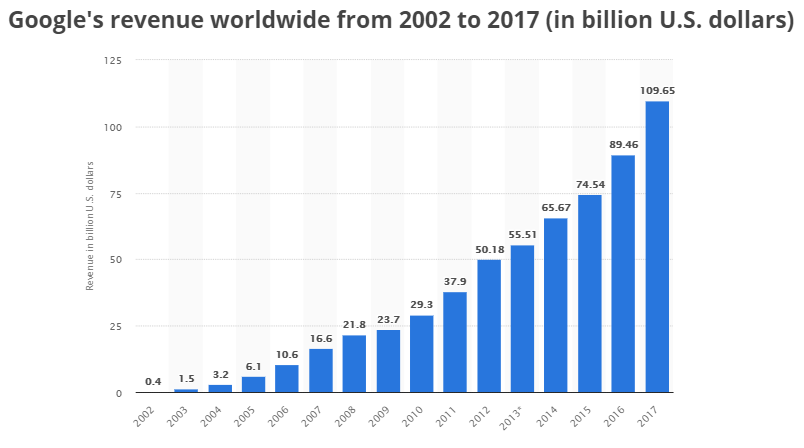
3. In 1999, it took Google one month to crawl and index 500 million pages. In 2012, it took less than a minute (Smart Insights)
Is there any better indication to prove Google's pace than this SEO statistic? In 13 years, the time it takes for their software to crawl and index 500 million pages has been slashed dramatically—from an entire month to less than 60 seconds.
But what does that mean for SEO pros?
Well, you might not be waiting as long for the changes you've made to take effect. That's never a bad thing—and could prove whether your strategy is working sooner, rather than later.
4. In 2017, Google changed its algorithm 13 times (Moz)

That's right: According to Moz's Google algorithm changelog, 13 changes were recorded in 2017 alone.
Furthering the point of Google's software team always being on the ball with their search engine, it means SEO experts can follow recently-updated guidelines to increase their chances of ranking highly.
But, this also comes with a warning:
Since their algorithm is changing so much, it's tricky to keep up.
Ranking factors, SEO features and the way Google's algorithm views a website are constantly evolving, so the "keep up or fall behind" motto really comes into full force here!
5. SEO leads have a 14.6% close rate, compared to 1.7% for outbound leads (Imforza)
Marketers always have one shared aim: To make sure the strategies they're executing have the highest possible return on their time, cash or effort investment.
If this is the biggest dilemma you're facing in your marketing department, remember this SEO statistic.
Proven to close more leads than outbound marketing—such as cold calling, radio advertising or promoting your business through tradeshows—adding SEO to your priority list is a no-brainer, really!
6. 45% of marketers plan to increase their SEO budgets (Marketing Charts)
Assigning budgets in your marketing strategy is tough. Remember what I mentioned about a marketer's biggest goal to be finding tactics with the best ROI?
It seems like we're finally cottoning on—almost half of the marketers asked in one survey admitted they're planning to increase their SEO budgets.
That's more businesses planning to up their cash on SEO than other tactics like webinars, PPC or display advertising.

On-Page SEO Stats
Defined as a set of actions that help a single page to rank higher in the SERPs, on-page SEO needs to play a part in your strategy—even if you're dealing with a site the size of Amazon's.
Here are the on-page SEO stats you'll need to give each individual page strong ranking power:
7. Improvements in content have been known to increase blog traffic by as much as 2,000% (Marketing Sherpa)
We all know that content marketing is crucial in SEO—that's no secret.
But by publishing blog content regularly, producing whitepapers, holding webinars and creating presentations, one company demonstrated that a 2,000% uplift in website traffic is a possibility.
And that's not all.
Since more people were visiting their site through platforms influenced by their SEO-optimized content, the company's revenue grew 40% year-on-year, and their cost per acquisition (CPA) reduced by 15%.
8. The average first-page result on Google contains 1,890 words (Backlinko)
When optimizing each individual page for SEO, remember this statistic.
Backlinko found a powerful correlation between total word count and ranking position when they analyzed over a million SERPs:
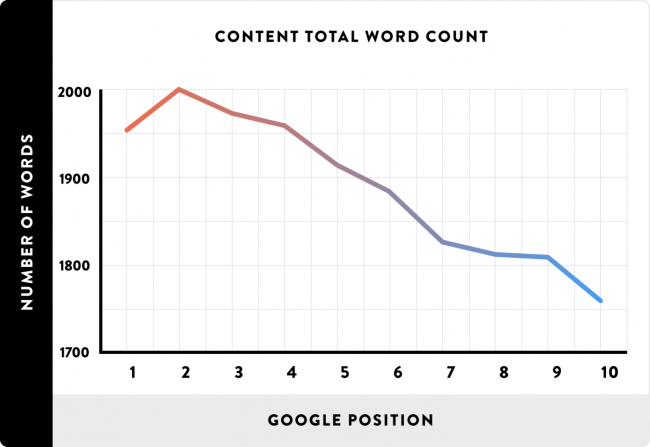
But why does this happen?
The strongest theory is that Google's main aim is to show the highest-quality, most relevant page for a user's search query. Content over 1,500 words is much more likely to be useful than a 500-word page, hence the higher rankings.
So, when you're crafting the content for each individual page on your website, don't be afraid to dive into detail. Include statistics, data points and explanations to back up your points, and you'll soon reap the rewards.
9. Companies that blog have 434% more indexed pages than those that don't (TechClient)
Although this might sound super obvious, it's an important one.
A higher number of indexed pages means a website has more chance of ranking in the SERPs. Why? Because if each page is targeting a small group of keywords, more pages equal more ranking opportunities.
Ready for a sentence that feels like I'm teaching you to suck eggs?
Committing to a regular blog schedule is proven to equal more indexed pages, simply because you've got more pages to index—and more keywords to target.
10. Brands and companies with blogs receive 97% more links to their website (State of Inbound)
Following on from the previous SEO stat I just shared, it makes sense that companies with a blog see almost double the number of backlinks to their website than those that don't have a blog.
The explanation is simple:
If you've got more indexed pages (and a wider range of resources) available on your blog, there's a higher chance of another author—who's looking to dish out a backlink—stumbling upon your website.
Since you're focusing on offering high-quality, long-form content, why wouldn't they choose your website as the perfect one to point their visitors to?
Off-Page SEO Stats
Now you've got the on-page basics covered, you'll need to put some thought into the off-page factors that influence where your site will rank in the SERPs.
So, keep these off-page SEO statistics in the back of your mind when planning a new strategy:
11. The average page in position #1 has 35,000+ external backlinks (Backlinko)
Here at SEOptimer, that's a statistic we love to shout about.
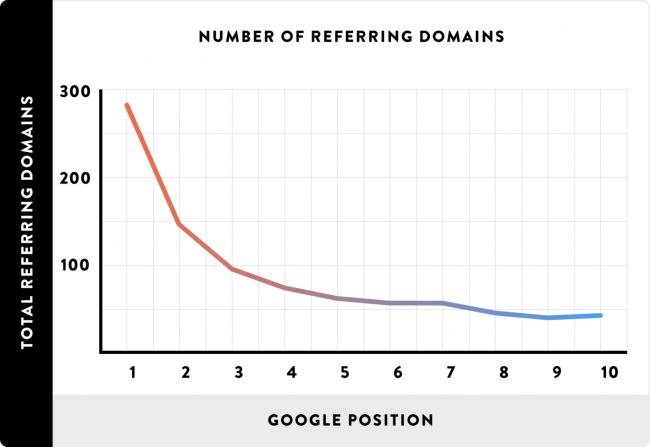
Backlinko's data proves that more backlinks equal higher Google rankings, and the explanation goes back to Google's main priority of showing the most relevant results for a searcher's query.
Think about it: If you were Google, which of these sites would you trust more?
A) A site with four backlinks from one referring domain
B) A site with 150,600 backlinks from thousands of referring domains
I'd choose option B every time.
Since thousands of other people are trusting the site enough to link to it, the site must be sharing something valuable, right?
12. 130,000 Facebook shares helped a site rank in position #1 for competitive keyword phrases (Matthew Woodward)
Google has said that social media shares don't count as links, but the debate on how social shares impact Google rankings rages on.
Just in case you missed it, here's Google's stance on the topic:
But after one company drove 130,000 Facebook shares to a page on their website, it seems like Google took note—and drove the page's rankings for competitive keywords to pride of place in the SERPs.
So, if you're looking to give a boost to a page's rankings, try to promote it through social media.
Although it might feel impossible to collect anywhere near 130,000 shares, there's still a chance of boosting your SERP position if you're able to add social credibility.
Local SEO Stats
If you're wanting to be in with the chance of appearing in local searches (like "grocery stores near me"), you'll need to make local SEO an integral part of your overarching strategy.
Here's why:
13. Almost a third of mobile searches are related to a location (Google)
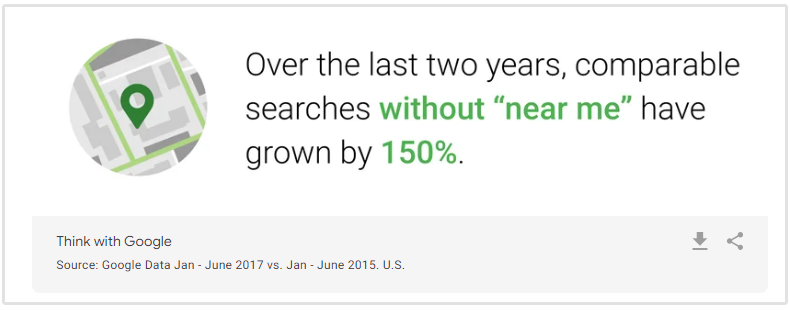
We think of Google as the place where we can find any information we're looking for—and a new wave of mobile searchers is using it for location-based information such as:
- Facilities nearby (i.e. "ATM near me")
- A local business's opening hours
But how can you use this SEO stat to fuel your local SEO strategy?
Here's your answer: Focus on creating pages that are optimized for local SEO, whilst making sure they're mobile-friendly. You don't want to frustrate mobile viewers with a landing page that isn't responsive.
That won't do anyone any favors, and is likely to make ranking on page #1 an even trickier task.
14. Mobile searches for "where to buy" have grown by 85% since 2015 (Google)
Whether you're selling garden patios or kitchen cutlery, you always want to be shown in "where to buy" searches. After all, these people searching have high commercial intent—they're very close to pressing the purchase button and handing over their cash.
However, when you're optimizing your site for this, don't forget to optimize for mobile.
Considering the huge growth in mobile "where to buy" searches since 2015, you want to make it easy for visitors to check out by:
- Using large, easy-to-click buttons
- Decluttering the checkout page
- Enabling social login
15. Business listings with a website get 25-35% more clicks (Google)
I've harped on about the value of Google My Business listings time and time again, and this SEO stat backs me up. It's essential to fill in each section of your listing if you want to make the most out of it.

Think about the reasons why potential customers view a business listing. It might be to find opening times, make a phone call or browse products on their website.
That's impossible for them to do if you aren't providing them with the information they need.
So, scan through your Google My Business listing and double-check each field is properly filled out. Then, test the link to your website is working—and be in with the chance to see upwards of 25% more clicks to your site!
Mobile SEO Stats
With the number of people making the switch from traditional desktops to mobile devices to use search engines, here are the mobile SEO stats that prove it could be the latest SEO phenomenon:
16. 90% of all mobile and tablet search traffic comes from Google (Net Market Share)
Bing and Yahoo! are still popular search engines, but when it comes to using mobile devices to make a search, Google is the platform of choice for over 90% of searchers.
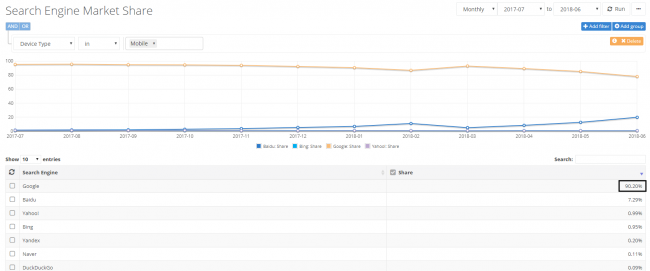
Fancy cashing in on this?
Focus on following Google's algorithm when planning your mobile SEO strategy—especially when it comes to PPC.
You want to target these mobile visitors where they're searching, so assigning a large chunk of your PPC budgets to Bing or Yahoo! ads could be a waste of time (and cash).
17. Mobile accounts for 52.2% of all web traffic (Statista)
I've already touched on the fact that Google takes the lead for mobile search engine traffic.
But I wanted to take that a step further with this statistic, which proves mobile internet usage isn't just important for SEO—it's taking the entire world by storm and accounting for over half of all global website traffic:
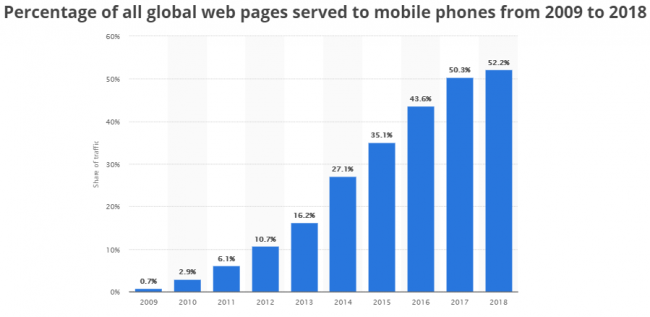
For SEOs, this proves the need for mobile SEO more than ever.
With such a dramatic shift in mobile internet habits, failing to keep up with the times could see you fall behind—and miss out on the ever-increasing number of internet users who are opting for mobile devices.
Voice Search Stats
"Should I really be focusing on voice search?" is a question on many SEO's minds.The answer isn't as clear-cut as you think—but these statistics might be worth considering:
18. 16% of Americans own a smart speaker (Edison Research and NPR)
In order to make a voice search, you'll need a device to enable you to do so. One of those devices is a smart speaker—such as the Amazon Echo, Google Home or Apple HomePod.
Granted, the 16% of Americans who own a smart speaker isn't a ginormous chunk of potential customers, but it's a significant chunk of the general public that could potentially use their smart speaker for voice searches.
Think about it: What could you do with a 16% increase in your website traffic?
19. Mobile voice-related searches are three times more likely to be local-based than text-related searches (Search Engine Watch)
Earlier, I talked about the surge of mobile searchers looking for local information.
Now combine that with the fact that voice-related searches are much more likely to be looking for local services, and there's a solid reason why you should be making it easy for local voice searchers to find your business.
Tips like:
- Replicating normal language (i.e. "where is the nearest Costco") on your website
- Building backlinks with the same backlink anchor text (i.e. "find my nearest pet food store")
- Creating "skills" on Amazon for voice searchers to complete an action (i.e. "order a pepperoni pizza from Domino's")
Ready to fuel your strategy using SEO stats that demonstrate the power of each tactic listed here?
That's great news—I can't wait to see your business crop up in my own search results!
Just remember not to restrict yourself to an idea of which route you should be heading in.
Use a combination of content and statistics to build a strategy that really pays off.










